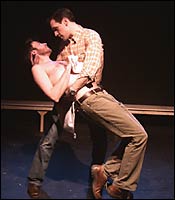
The locus of Adam Bock’s Five Flights is somewhere between impudence and inanity. Ostensibly about what to do with a huge, crumbling aviary inherited by the children of a man who built it to house his deceased wife’s soul, which he claimed to recognize in a bird that may have been a wren, it is really about several other things that add up to pretty much nothing. After the purported wren was moved from the doghouse to the grand new aviary, the man and his daughter, Adele, went about netting further bird-souls and lodging them in the house-size aviary.
But Ed, Adele’s brother and the play’s narrator (the five meaningless sections have titles trendily projected on the backdrop), stands by during the opening quarrel between his sister-in-law, Jane, who is for tearing down the aviary and replacing it with a megastore and parking lot, and Adele’s chum, Olivia, who is for converting it into a Fifth Day church (“fifth day” being the one on which God created birds), where, having heard His voice, she can preach. Bobby, the other son and Jane’s husband, remains unseen. Olivia draws into the argument a bystander, Tom, who instantly falls in love with Ed. Tom is a professional hockey player and ballet lover, pursuits on whose alleged similarities he vacuously expatiates. His teammate Andre encourages him to publicly demonstrate his affection for Ed, which he finally does in a series of prolonged, voracious kisses.
As written and staged by Kent Nicholson, characters (sometimes seminude males) make unmotivated entrances and exits, crisscross the stage in contradictory directions, and, when stationary, usually face the audience. Holding unlikely poses or broadly gesticulating, they often whisper inaudibly or shout unbearably. The only event is a mimed trip to the ballet, where four on a bench turn in unison, first their heads, then their bodies, into pendulums, eventually lurching forward, then leaping up in synchronous ecstasy.
You may rightly gather that the aviary is not the only thing for the birds here, especially when you consider that the generally flat dialogue thrives on gratuitous repetition and stillborn tropes, e.g., “The red feet of the ducks are the blood of martyrs.” It is sad to find a performer of the stature of Alice Ripley (Olivia) stuck, frequently shrieking, in this morass, to which some of the others seem ideally suited.
People who love musicals and enjoy seeing them affectionately kidded, as well as many others, got quite a kick out of the rather pleonastically titled The Musical of Musicals: The Musical! by Eric Rockwell (music), Joanne Bogart (lyrics), and book by both. The idea was to take a deliberately platitudinous plot—distressed impecunious maiden about to be evicted by mean and lecherous landlord, defended by loving and valiant hero, and counseled by savvy older woman—and presenting it as five mini-musicals in the manner of Rodgers and Hammerstein, Stephen Sondheim, Jerry Herman, Andrew Lloyd Webber, and Kander and Ebb, with a brief finale out of Marvin Hamlisch.
One had to admire the authors’ intimacy with the things they lovingly lampooned, and the deftness and piquancy with which they put that familiarity to use: Not a little verbal and musical cleverness went into these five flights of fancy. The tunes managed to be delightfully in the spirit of the originals, and the words gloried in sometimes using the originals’ phrases in a hilariously new context, or mischievously punning on them. Even the titles of the skits were charming, e.g., for R & H, the double-bottomed “Corn,” and for Sondheim, the ambiguous “A Little Complex.” Was it the fault of the models or of the parodies that the Lloyd Webber and Kander and Ebb takeoffs were not quite up to the others?
The amiable quartet of performers comprised Lovette George as the pleasantly tomboyish maiden, Craig Fols as the funny but somewhat repetitious swain, and the co-authors, Joanne Bogart as the older woman (comical but slightly out of voice—temporarily, I hope) and Eric Rockwell, playing the piano or clowning as the villain with equal verve under Pamela Hunt’s direction and minimal choreography. Minor lapses could easily be pardoned, given the York Theatre Company’s laudable dedication to musicals old and new.